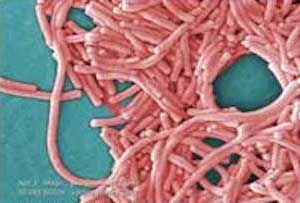The Michigan Department of Health and Human Services (MDHHS) is pursuing an ongoing investigation of an unprecedented spike in Legionnaires’ disease cases in Flint, MI and Genesee County following Flint’s “cost-saving” switch to a new water system from Detroit’s treated Lake Huron water to Flint River water in April 2014.

On December 15, 2015, Flint Mayor Karen Weaver declared a state of emergency because of the city’s toxic potable water supply. Yesterday, January 13th, Michigan governor Rick Snyder announced that he was marshalling the assistance of the National Guard and FEMA to provide bottled water, water filters, and testing kits to the citizens of Flint after studies confirmed high levels of lead in the municipal water system. He also informed the public about the troubling increase in Legionnaires’ disease cases that have occurred in the summers of 2014 and 2015.
The normal rate for Legionnaires’ disease cases in Genesee County is 6-13 cases per year. According to a MDHHS press release, 45 LD cases were confirmed in Genesee County from June 2014 to March 2015; 7 people died. Subsequently, from May 2015 to November 2015, 42 cases were identified, including 3 fatalities. Victims ranged in age from 26 to 94.
MDHHS first began tracking the outbreak in the fall of 2014 after it noticed the spike in cases. By January 2015, it took charge of the Genesee County Health Department (GCHD)’s investigation of new cases, creating interview and surveillance tools to try to assess the sources of all reported cases.
MDHHS ascertained that in the first 45 cases in 2014, the primary source of water at the victims’ primary residences was City of Flint water for 47% of the cases. However, it also found that more than half of these victims had also been admitted to a healthcare facility within 2 weeks of the onset of Legionnaires’ disease, raising the possibility that they had contracted LD from Legionella pneumonia bacteria on the premises. Genesee County hospitals were warned of the increase in cases in January 2015, and encouraged by MDHHS to heighten surveillance, testing, identification, and reporting of potential new cases.
10 of the cases had no exposure either to the Flint water system or to a Flint hospital.
Legionnaires’ Disease in Municipal Water Systems
Legionnaires’ disease has been described as “Public Health Enemy #1 in US Water Systems” by professional engineers such as Steve Hubbs, former Vice President of Water Quality and Protection at the Louisville Water Company. Hubbs bases this assessment in part upon the published research of chemist and former Environmental Protection Agency Office of Water official Dr. Joseph Cotruvo:1
“According to … Cotruvo, the risk of acquiring legionellosis from inhaling water mists contaminated with Legionella, although small, is now the most significant waterborne disease risk associated with municipal drinking water supplies. The author notes that Centers for Disease Control and Prevention (CDC) data show 19 of 33 (58%) [of] waterborne disease outbreaks reported in 2009-2010 were associated with Legionella in plumbing systems or drinking water distribution systems. These outbreaks resulted in 105 cases of illnesses and 14 death. Legionellosis outbreaks were the only waterborne outbreaks in that time period that resulted in deaths.”2
The hazards posed by the presence of Legionella pneumonia bacteria in a city’s water system are confirmed by Virginia Tech professor Marc Edwards, who has been investigating Flint’s water system issues under a $50,000 National Science Foundation Rapid Response Research grant awarded in September 2015. Edwards, who was initially brought on board to study elevated lead levels in Flint’s public water supply, now points out that “It’s not unexpected that the lack of corrosion control could have triggered that [Legionnaires’ disease] … Legionella likes water that has little or no chlorine and has high iron … Both those factors would contribute to the growth in Legionella.”3
Cotruvo’s research supports this conclusion:
“Legionella can colonize water distribution lines and building plumbing, contaminating water supplies after it has been centrally treated. The bacteria may be harbored in slimy coatings known as biofilms on pipe interiors, where it is protected from sufficient contact with disinfectants. All that is needed to colonize a pipeline is a few Legionella bacteria. These may enter the pipeline as “escapees” from the water treatment process, “intruders” at water main breaks, or “stowaways” at the time of pipe installation.”4
Our law firm is not taking these cases.
Sources:
- Cotruvo, J.A. (2014). Facilitating supplemental disinfection for Legionella control in plumbing systems, Journal of the American Water Works Association, Vol. 106, No. 8. / Cotruvo, J.A. (May, 2014). Professor POU/POE—Waterborne Diseases Technology Online. Available online: http://www.watertechonline.com/articles/167968-professor-poupoe-may-2014.
- Hubbs, Steve. “Addressing Legionella: Public Health Enemy #1 in US Water Systems.” Water Quality and Health. Web.29 Aug. 2014 [date cited: 14 Jan. 2015].
- Fonger, Ron. “Expert says Legionnaires’ outbreak could be tied to Flint water switch.” MLive Media Group. Web. 13 Jan. 2016 [date cited: 14 Jan. 2015].
- 4. Hubbs, Steve. “Addressing Legionella: Public Health Enemy #1 in US Water Systems.” Water Quality and Health. Web.29 Aug. 2014 [date cited: 14 Jan. 2015].